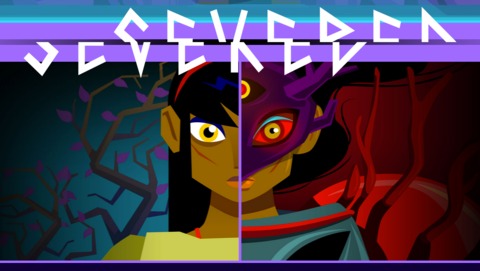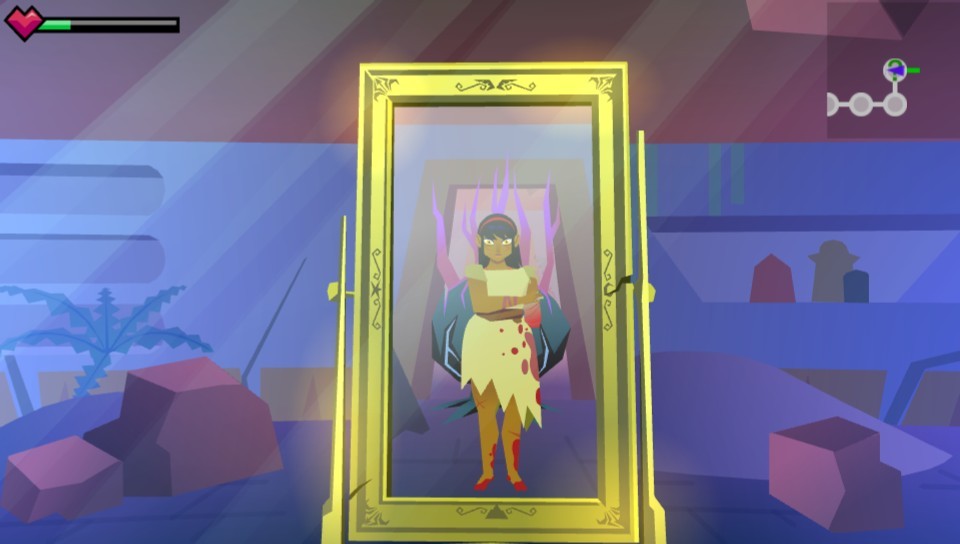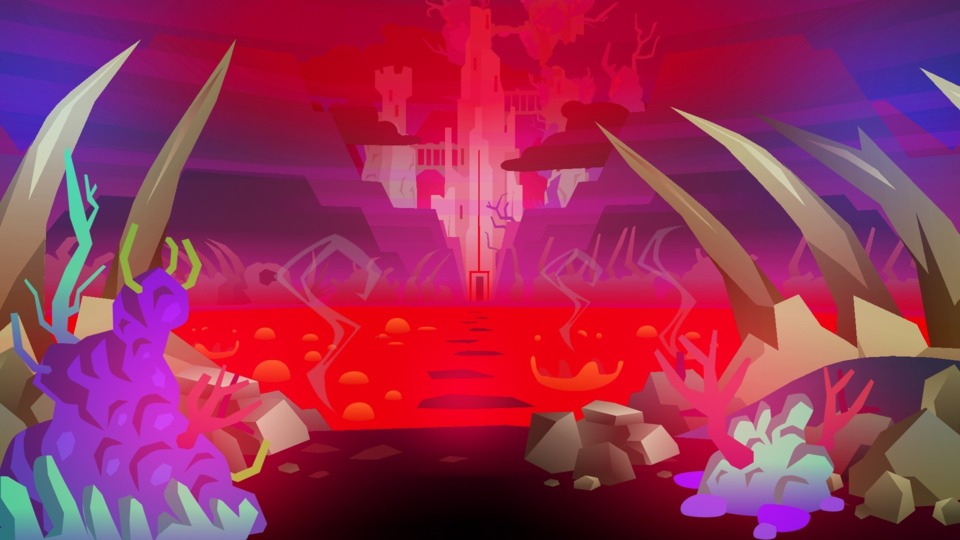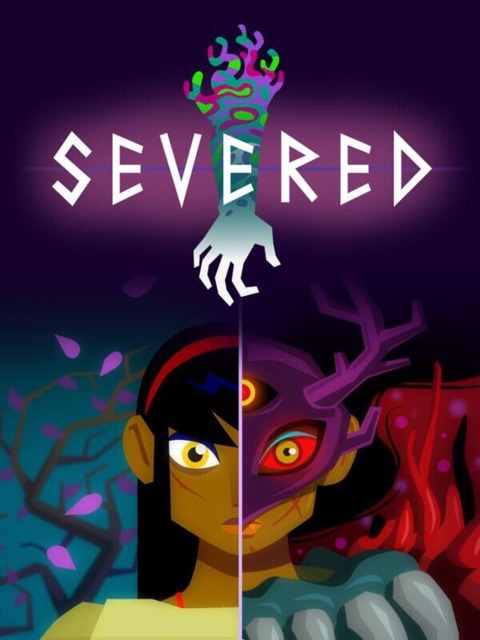
Now this was a pleasant surprise. DrinkBox Studios's Severed shares a lot of similarities with their previous game, Guacamelee!; in particular, both have a very distinct vector-based visual direction inspired by the iconography and vivid colors of Mexican/Central American art, and both involve exploration, puzzle-solving and a combat system that focuses on exploiting weaknesses and managing multiple foes. While Guacamelee delved into the absurd dramas of Lucha Libre in a 2D platforming SpaceWhipper environment, however, Severed is a more somber tale about a young woman's possibly doomed journey to rescue her family from a nightmarish mirror dimension in the style of Orpheus and Eurydice, where every desperate battle in this primal and violent land threatens to rob her of her humanity.
It's a strange coincidence, given that this game's been out for a year on the Vita (I played the more recent Wii U version, for the record), that I started playing Severed around the time I began watching the excellent new season of Genndy Tartakovsky's Samurai Jack. The powerful, compassionate warrior lost in a realm of nightmares and constant struggle are a close match, sure, but it's more in how both DrinkBox and Tartakovsky create these worlds of harsh angles and brightly colorful backgrounds that are somehow simultaneously simple in form and breathtaking to behold. It's a wonderful use of shape and color that I can't quite elaborate on with my lack of an artistic background, but stripping the silliness and memes of Guacamelee! has really helped that visual style stand out all the more in Severed, as does I suppose putting the game entirely in first-person. Vector graphics haven't won me over in the past - I tend to think they make everything look like a Flash game - but there are a few intermittent examples like Severed that make a strong case for the format.

Playing Severed, it almost feels like a reimagining of the classic real-time dungeon crawler in the vein of Dungeon Master or, to name a more recent example, the Legend of Grimrock games. You find switches and keys, must figure out how to open doors, occasionally press secret panels on walls to open new exits, and avoid or disable the occasional trap. While movement is four-directional and the dungeons work in a discrete grid-like manner, you have a full panoramic view of every "square" in the game, which is needed for both scanning the environment for secrets and items as well as the combat, which often pits you against multiple enemies in every direction. Also, like Guacamelee, an effort has been made to mitigate the amount of searching and backtracking involved: every space on the map is annotated for color-coded doors, secret passages that require an ability you'll find later, and green question marks for secrets which is just vague enough a clue to maintain a level of mystery without the need to scour every wall on every dungeon's floor for hidden switches. The most common rewards for secret passages and those you can only open in a later revisit are health and mana upgrades, so it's worth trekking back to see what's now accessible if you have a boss coming up. The game is happy enough to reserve its difficulty for the battles themselves, and therefore de-emphasizes the "challenge" of finding secrets to compensate by clearly marking them all on the map - depending on the type of player you are, especially for this type of game, it may be a decision to be applauded or derided.
Severed's meat and potatoes is its combat. The game is entirely touch-based for these sequences, with the player's finger or stylus representing their sword slashes. Every enemy in the game is susceptible to getting slashed repeatedly with the protagonist's Soul Edge-looking blade, though most require that you finagle their weak points out of hiding first. Some enemies start blocking certain angles from which the slashes might rain down, others require that you eliminate non-crucial targets for the real ones to appear, while others still are simply a matter of timing and waiting for an opportunity. To Severed's credit, they came up with a lot of monster types, and while most get recycled into harder versions they usually have an extra twist to the tale. For instance, about halfway through the game you learn the ability to hold the stylus down to charge attacks, and this becomes necessary to destroy these orange, rocky barriers in the dungeons. Enemies start adopting these rocky barriers also, giving you an extra step to overcome before you can damage them.

The icing on the cake is how the player harvests organic crafting items, however: each enemy also has a certain amount of limbs and viscera that can be severed from them and collected, but in order to do this you have to build a "focus" gauge which climbs higher with successive hits. Spamming enemies isn't enough: the chain is broken if you miss or get blocked, so in order to fill the gauge quickly you must seize upon short moments of vulnerability to get in as many hits as possible. However, going for maximum damage will kill your enemy before the gauge is filled, wasting what pieces you could've harvested from them. Early on in a fight, you learn to use short, less damaging strikes in quick succession to build your focus bar, before switching to longer strikes that cause more damage to eliminate enemies quickly. It's important to defeat enemies fast because you're very rarely attacked by just one: many fights become an act of spinning plates, as you're often pivoting around quickly to deflect enemy attacks from every angle. By removing specific enemies quickly by focusing on them first, you mitigate the amount of damage you might receive, but that also makes it difficult to build the focus gauge in time to harvest them. It's a really smart risk vs. reward dynamic that can be overcome if you're exceptionally fast, but will often involve killing the monster with the least necessary parts first just for the extra breathing room. The parts you acquire can then be spent on upgrading your character, enhancing the damage they do or adding bonuses like siphoning life or causing critical hits. Eventually, the protagonist also learns to blind enemies (temporarily putting them out of service) and consuming their buffs (which removes their buffs and gives them to you) - both of these also have their own skill trees, which means you're always in need of more parts. Mercifully, the game also lets you collect "giblets" from breaking vases in the environment which can be transmuted into any type of crafting item, which is a huge godsend when you're a few arms or horns short of the next big upgrade and aren't sure when you'll next fight a monster that drops either. In addition, there are no random encounters in the game and every monster disappears forever once fought; the sole exception is a trap room at the very end which generates a random encounter with each pull of a switch an apparently endless number of times, in case you're still missing some upgrades.
I didn't hear as much effusive press surrounding Severed as I did with Guacamelee, possibly because it was a Vita exclusive for a long while, which is a shame because I consider it a far better game overall. The art is put to better use in a first-person view where it's far more striking and vivid, its serious yet simple story of revenge and losing oneself to one's rage serves the whole Mexican/Central American folklore aesthetic well, the enemies and bosses - while still challenging, especially the end boss - are far more balanced and fair than Guacamelee's with a much better thought out difficulty curve, and deep down the game is still a SpaceWhipper with its emphasis on exploration and backtracking, but also offers something a little more uncommon with its dungeon-crawling first-person format. It's perhaps a game ideal for a portable format, but I enjoyed my time with the Wii U version immensely and I'm psyched to see what Drinkbox will do next if they can maintain this trajectory.
Rating:5 out of 5.
| < Back to 15: Tales from the Borderlands E1 & E2 | > Forward to 17: Tales from the Borderland E3 & E4 |

Log in to comment